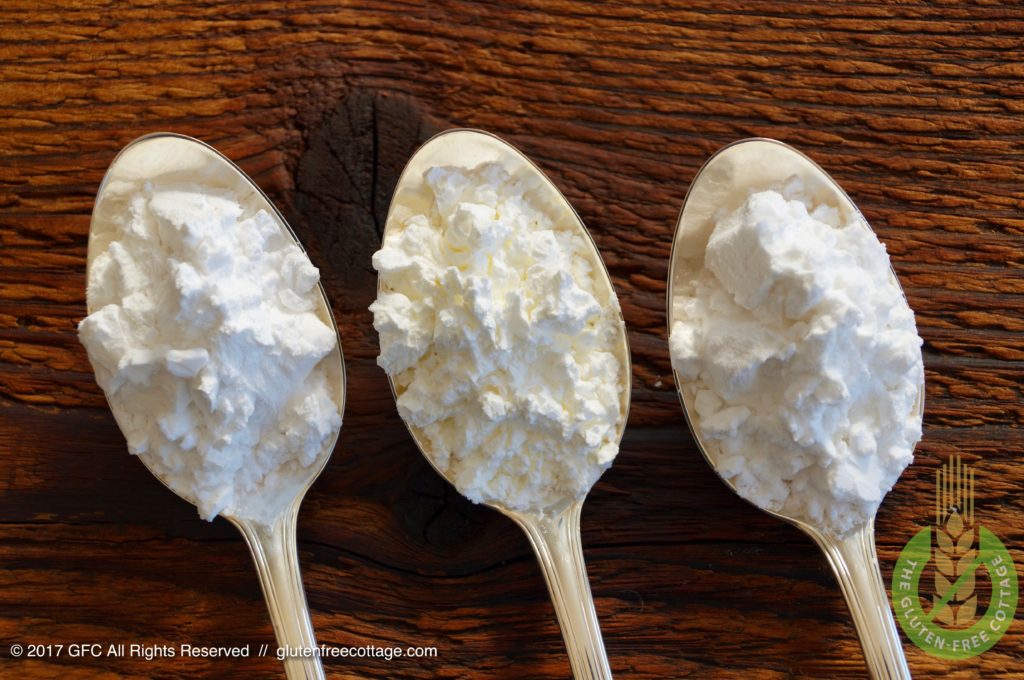
Gluten-free starches and extra binding agents are needed in gluten-free baking because they are able to give back at least part of the missing “bakability” of gluten-free flours. The main starches for gluten-free baking are arrowroot, corn, potato and tapioca starch (alphabetic order).
Gluten-free starches are used as binding agents in gluten-free batters and doughs and they also help lighten the texture of baked goods (soft crumb) and improve their mouth feel. They have the ability to absorb a multitude of water and then swell as a consequence. Subsequently, when heated, starches agglutinate.
Gluten-Free Starches (in an Alphabetic Order)
Arrowroot Starch
- MADE FROM: edible rhizomes (rootstock) of several tropical plants; traditionally from plant Maranta arundinacea which belongs to arrowroot (or prayer-plant) family; cultivated in tropical countries (e.g. Jamaica and St. Vincent, Brazil, Thailand, but also Florida);
- TASTE: neutral taste;
- USED FOR BAKING: sweet and savory baked goods like bread, cakes and pastry;
- SPECIAL BAKING PROPERTIES: use in gluten-free flour mixes; very good thickening and binding agent (thickens at a lower temperature than other starches); gives a good consistency to baked goods and makes them light and soft; can be used instead of eggs; easy to digest (better than other starches); => back
Cornstarch (Maize)
- MADE FROM: endosperm of sweetcorn kernels (very finely ground); belongs to cereal grains; world-wide cultivation;
- TASTE: mild taste (almost tasteless);
- USED FOR BAKING: sweet and savory baked goods like muffins, cakes and bread.
- SPECIAL BAKING PROPERTIES: mix with other gluten-free flours; cornstarch makes for a nice and smooth consistency of the dough; gives baked goods a finer and lighter structure (makes them softer and more fluffy), but makes them more crumbly at the same time; very good binding and thickening agent for liquids in the dough; provides for a good crust of baked goods; => back
Potato Starch
- MADE FROM: peeled potatoes; potatoes are tuber vegetables and belong to the nightshade family; originally from South America;
- TASTE: neutral taste;
- USED FOR BAKING: sweet and savory baked goods like bread, muffins and cookies;
- SPECIAL BAKING PROPERTIES: good baking properites and very good ability to bind water (swelling capacity); very good thickening and binding agent; mixes very good with gluten-free flours and provides a nice, smooth texture of the dough; gives a fine consistency to baked goods and helps retain moisture; but quite dense starch (provides a sort of “heavy” density); therefore use only carefully in baked goods; => back
Tapioca Starch
- MADE FROM: tuberous roots of the manioc plant (cassava); special treatment necessary to remove toxicity from manioc tubers; then starch is generated from pressing a starch-rich liquid from manioc pulp; cassavas (also called “Brazilian arrowroot”) are tuber vegetables and belong to the euphorbia (or spurge) family; cultivated in tropical and subtropical regions, especially in Brazil, Thailand and Nigeria;
- TASTE: neutral, slightly sweet taste;
- USED FOR BAKING: sweet and savory baked goods such as bread and cookies;
- SPECIAL BAKING PROPERTIES: quite good baking properties; good binding agent; makes doughs smoother so you can better work with it; helps baked goods become light and fluffy; tapioca starch has a light, soft and very fine structure and is one of the purest forms of starch food; it adds brown colour to baked goods; => back
Other Starches
- Sago Starch: spongy centre (pith) of various tropical palm stems; cultivated in Papua New Guinea and Southeast Asia; not very well-known in Europe; sago palm trees are protected; => back

The Gluten-Free Cottage (GFC)
© 2016 GLUTENFREECOTTAGE.COM ALL RIGHTS RESERVED